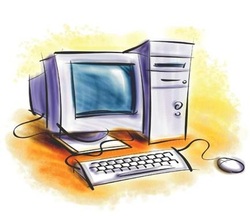Computer Peripherial Devices
Computer Peripherial Devices
The input, output and storage devices surround the central processing unit (CPU) are called the peripheral devices. They are usually the electromechanical devices connected to the CPU that exchange data and programs with the CPU. The users interact with the CPU through these devices. Thus, they act as interface between users and the CPU. The interaction is difficult because of the language barrier. The CPU uses machine language, which is difficult for most users. The input- output (1/0) devices help in taking the translated version of the input to the machine's memory and similarly, to render the processed symbols into the language of the user.
During the first two decades of commercial use of computers, 110 operation was performed mostly by punching holes on cards and paper tape with a special device. More direct and convenient 1/0 devices have been developed since then. The peripherals connected directly to the CPU are called online devices and devices not directly connected are called offline devices.
The peripherals can be further divided into :
1. Input Devices
2. Output Devices
3. Computer Memory
Input Devices
Input devices allow the user to input data and instructions to the computer.
Output Devices
Output devices help us to get the information from computer. This devices is a link between computer and users.
Computer Memory
Computer memory is just like a human brain. It is used to store data and instructions. Computer memory is the storage space in computer where data is to be processed and instructions required for processing are stored.
